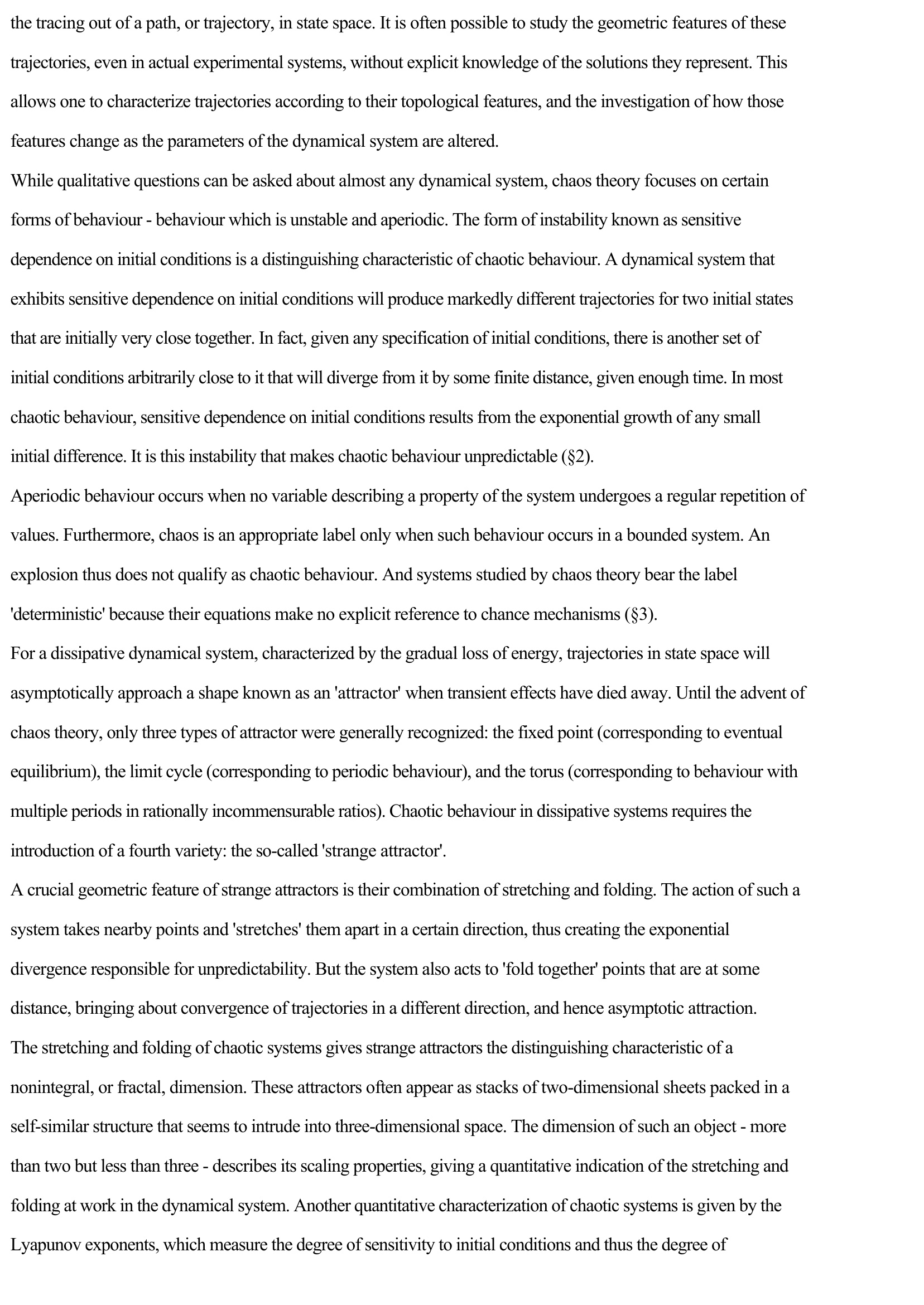Chaos theory
Publié le 22/02/2012

Extrait du document
«
the tracing out of a path, or trajectory, in state space.
It is often possible to study the geometric features of these
trajectories, even in actual experimental systems, without explicit knowledge of the solutions they represent.
This
allows one to characterize trajectories according to their topological features, and the investigation of how those
features change as the parameters of the dynamical system are altered.
While qualitative questions can be asked about almost any dynamical system, chaos theory focuses on certain
forms of behaviour - behaviour which is unstable and aperiodic.
The form of instability known as sensitive
dependence on initial conditions is a distinguishing characteristic of chaotic behaviour.
A dynamical system that
exhibits sensitive dependence on initial conditions will produce markedly different trajectories for two initial states
that are initially very close together.
In fact, given any specification of initial conditions, there is another set of
initial conditions arbitrarily close to it that will diverge from it by some finite distance, given enough time.
In most
chaotic behaviour, sensitive dependence on initial conditions results from the exponential growth of any small
initial difference.
It is this instability that makes chaotic behaviour unpredictable (§2).
Aperiodic behaviour occurs when no variable describing a property of the system undergoes a regular repetition of
values.
Furthermore, chaos is an appropriate label only when such behaviour occurs in a bounded system.
An
explosion thus does not qualify as chaotic behaviour.
And systems studied by chaos theory bear the label
'deterministic' because their equations make no explicit reference to chance mechanisms (§3).
For a dissipative dynamical system, characterized by the gradual loss of energy, trajectories in state space will
asymptotically approach a shape known as an 'attractor' when transient effects have died away.
Until the advent of
chaos theory, only three types of attractor were generally recognized: the fixed point (corresponding to eventual
equilibrium), the limit cycle (corresponding to periodic behaviour), and the torus (corresponding to behaviour with
multiple periods in rationally incommensurable ratios).
Chaotic behaviour in dissipative systems requires the
introduction of a fourth variety: the so-called 'strange attractor' .
A crucial geometric feature of strange attractors is their combination of stretching and folding.
The action of such a
system takes nearby points and 'stretches' them apart in a certain direction, thus creating the exponential
divergence responsible for unpredictability.
But the system also acts to 'fold together' points that are at some
distance, bringing about convergence of trajectories in a different direction, and hence asymptotic attraction.
The stretching and folding of chaotic systems gives strange attractors the distinguishing characteristic of a
nonintegral, or fractal, dimension.
These attractors often appear as stacks of two-dimensional sheets packed in a
self-similar structure that seems to intrude into three-dimensional space.
The dimension of such an object - more
than two but less than three - describes its scaling properties, giving a quantitative indication of the stretching and
folding at work in the dynamical system.
Another quantitative characterization of chaotic systems is given by the
Lyapunov exponents, which measure the degree of sensitivity to initial conditions and thus the degree of.
»
↓↓↓ APERÇU DU DOCUMENT ↓↓↓
Liens utiles
- CHAOS ET LA Nuit (le), de Montherlant
- THÉORIE DU SON [Theory of Sound]. Résumé
- THÉORIE DE LA JUSTICE, A Theory of Justice, 1971. John Rawls (résumé & analyse)
- Le Chaos et la Nuit, Celestino Marcilla
- CHAOS DE TRIPERUNO (Le) (résumé & analyse)

































